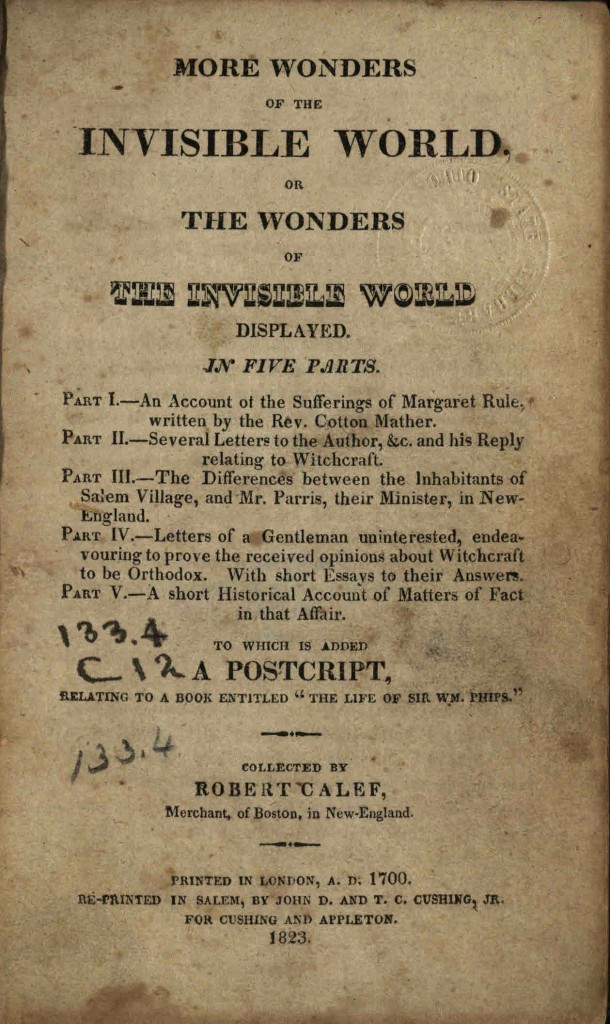“More Wonders of the Invisible World”

This week marks the anniversaries of two events in the history of witch trials in the United States. On May 26, 1647, Alse Young became the first person to be hanged as a witch in the American colonies when she was put to death in Hartford, Connecticut. The second anniversary occurred on May 27, 1692: the 323rd anniversary of the establishment of a Court of Oyer and Terminer, which heard and ruled upon witchcraft cases in Salem, Massachusetts.
Over the subsequent years, countless publications have detailed the Salem Witch Trials, including ones written by those who witnessed the trials and those who have used early published works to find new insights. Most seek to determine why the young girls from Salem acted out and accused members of their communities of witchcraft. No definitive answer has been found and, as time goes on, it is unlikely that we will ever know just what happened. However, due to the nature of the events and their terrible outcomes, many materials relating to Salem and to witch trials in general continue to be available to us.

One such item is More Wonders of the Invisible World, a collection of primary materials gathered by Robert Calef of Boston. Originally published in 1700 – our edition was published in 1823 – it is organized into five parts and includes a letter from the author, a piece written by well-known Puritan minister, author, and scholar Cotton Mather, a retrospective on the Salem Witch Trials, and other items relating to witchcraft in New England. Calef makes his views clear from the beginning:
And as to most of the actors in these tragedies, though they are so far from defending their actions, that they will readily own that undue steps have been taken, &c. [sic] yet it seems they choose that the same should be acted over again, enforced by their example, rather than it should remain as a warning to posterity…. So far are they from giving glory to God, and taking the due shame to themselves.
Calef clearly wants to demonstrate to his readers that witch trials – he speaks primarily of Salem here – were a travesty and reflected very poorly on the colonies in their entirety, not just Massachusetts. He hopes, by publishing the documents he has included, he will ensure that the terrible acts of 1692 will be remembered and will not recur.
While, unfortunately, witch trials did continue, none were as tragic as those in Salem. In fact, even here in Ohio at least one witch trial took place: in Bethel, Ohio, a case was tried in 1805 in which two young girls from the Hildebrand family accused their neighbor, Nancy Evans, of witchcraft. For her trial, Ms. Evans was placed in a special “witch chair,” allowing her weight to be compared to that of the Bible. According to the History of Clermont County, Ohio (Philadelphia, PA: L.H. Everts,1880), “A tradition prevailed that if a witch were weight against the Holy Writ, so great would be the overpowering influence of the Bible that the witch would be compelled to tip the beam [of the scale].” In other words, had Ms. Evans been a witch, the Bible would outweigh her when her weight was measured against it.

Ms. Evans, however, was much heavier than the Bible, and was found innocent of wrongdoing: “Nancy Evans…was thenceforth relieved from all suspicion of being more than a simple old woman, who willingly submitted to this novel process in order to bring peace of mind to her neighbors, whom she sincerely pitied.” On August 21, 1953, the Amherst News-Times ran a story on this very case as part of their “True Tales about Ohio” feature. You can read more about it on page 8 of the paper, which you’ll find here on Ohio Memory.
Thank you to Shannon Kupfer, Digital/Tangible Media Cataloger at theState Library of Ohio, for this week’s post!



Leave a Reply
You must be logged in to post a comment.